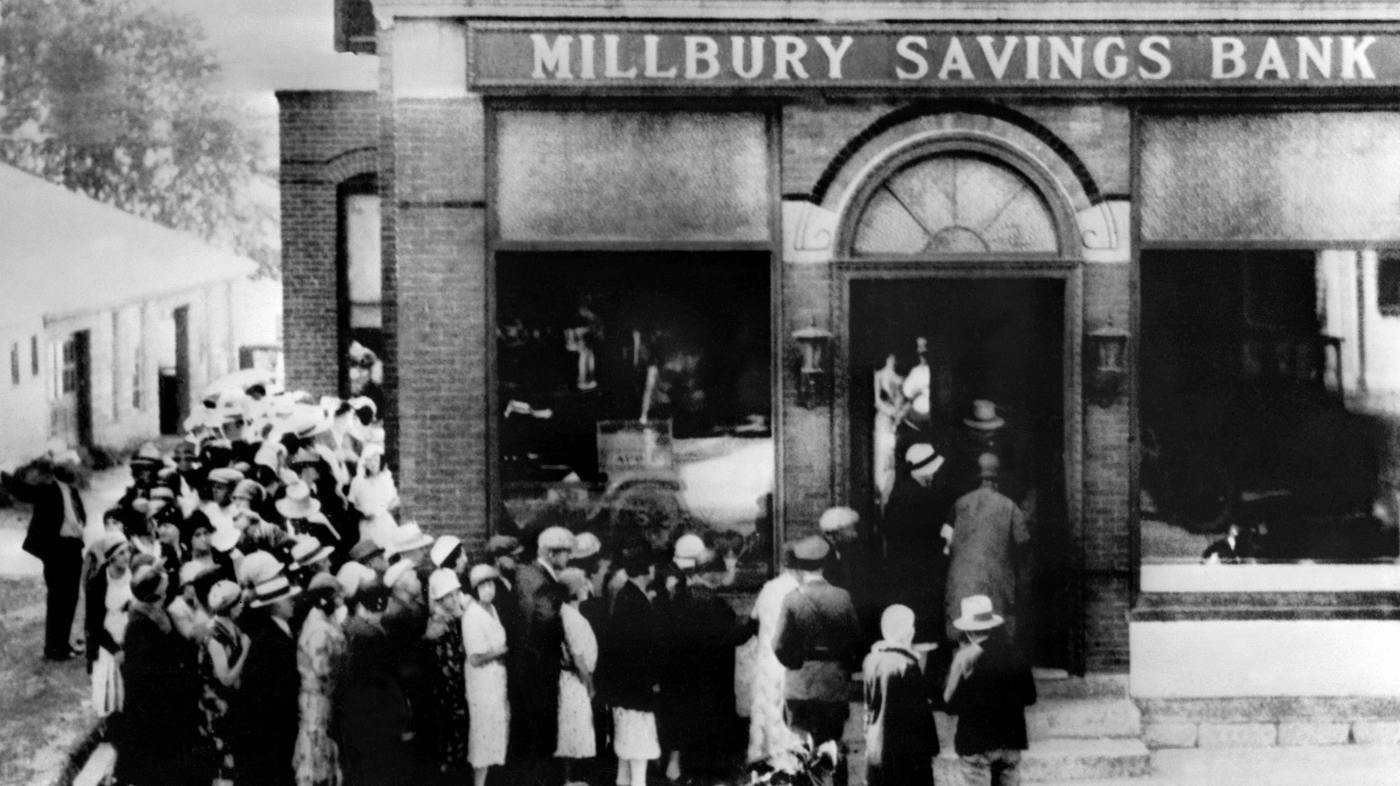What Will Devaluation Mean To You?
[This 1934 monograph is the first publication of the American Institute for Economic Research. It was a response to FDR’s bank closing, gold confiscation, and devaluation]
Devaluation, or clipping the coinage, as the process was called in the days of the Robber Kings, is a subtle form of taxation. Like most other taxes, those imposed by this insidious method will be borne by the Forgotten Man.
That modest citizen referred to in Sumner’s graphic phrase may be called the average man. He works for a living; is industrious and thrifty, saving for the proverbial “rainy day.” Life insurance is his bulwark against the major uncertainty of existence. He builds slowly but surely, not expecting great profits; and strives to give his children a better chance in life than was his lot. Above all, he pays the taxes.
The effects of devaluation upon the Forgotten Man, who is the warp and woof of our civilization, are of vital significance. He has a right to know what these things mean.
Taking Gold from the Dollar
Technically, devaluation is reducing the amount of precious metal in the dollar, but this is only the first link in a chain of important effects. The initial act may exert its influence on the economic scheme in one or more of three different ways. It will be simpler to discuss each one of them in turn, although they may all be in operation simultaneously.
In the first place, the fact that the gold content of the dollar is reduced necessarily means that newly mined gold will be worth a larger number of dollars than it would otherwise have been. Newly mined gold, in so far as it is used for monetary purposes, becomes purchasing power flowing in the channels of trade. It is apparent that the annual additions to the flow of circulating money or purchasing power will be definitely increased by this policy of reducing the gold content of the dollar. But since the amount of gold coin or circulating notes which represent it is quite a small portion of the total purchasing power in use, it is clear that the extra value given to newly mined gold will be very small in proportion to all purchasing power in use.
The second means by which the devaluation process may affect price relationships depends upon the use made of the profit on existing stocks of gold. Because of the recent action of Congress, it is now generally understood that there will be a profit of $2,800,000,000 or more on the gold which is held by the Federal Government or its agencies. This enormous sum of money may be used merely by issuing gold certificates, backed by that portion of the gold which is no longer needed to secure other circulating currency. When the Government uses this volume of purchasing power, either to buy additional gold abroad or for public works projects, or even to buy back Government Bonds, there will be a consequent addition to the purchasing power already in use. If this fund is used within a fairly short period of time, it may have an immediate and very great stimulating effect on many prices.
Enormous Credit Expansion to Follow
In the process of spending this profit on existing gold reserves, the Government will presumably deposit certificates in the Federal Reserve Banks and draw checks against the accounts thereby established. As payments are made to the citizens of the country or to various businesses and institutions, these governmental credits or deposits in the Federal Reserve Banks will be transferred to other banks throughout the country. The result will be greatly to enlarge the reserves of banking institutions, providing them with more than is required by law.
Should they decide to spend these excess reserves or to invest them, the result will be to increase demand deposits, which are themselves used as purchasing power when circulated by the checking process. The striking feature involved in such action is that demand deposits may be built up to an amount approximately ten times as large as the excess reserves thereby made available to the banking system.
Will Boost the Price Level
That the procedure above described will affect the price level is certain. It is impossible to foresee at this time whether all of the methods described will be in operation. Therefore, there is some doubt as to the rate at which the rise may take effect. It is more important for our purpose, however, to know how far the rise will probably go. A reasonable estimate of the price level to be expected can be made after first considering what prices would have been in the absence of the devaluation process.
It is now generally recognized by economists that the price rise during the World War was one effect of the enormous credit inflation carried on by the principal combatant nations at that time. Furthermore, it is now understood, and proved by research recently completed, that the price level from 1922 to 1929 was also artificially supported by the process of inflation.
In view of the fact that some observers have feared that declining prices during recent years were due to a real shortage of gold in the world, certain important facts should be made clear. Gold production just prior to the World War was approximately 22,000,000 ounces per year. Of course, high prices caused by inflation during the war and the decade of the 20’s greatly discouraged production of gold, inasmuch as costs of producing gold went up with other rising prices. In 1932, however, gold production exceeded pre-war levels; and in 1933 production has been estimated at 24,000,000 ounces.
Without going further into technical details of the subject it may be asserted that the normal price level, had the old valuation of the dollar been retained, would have been in the neighborhood of 90% of pre-war prices.
Computing the price level to be expected as the result of devaluation is a fairly simple process. Since the gold content of the dollar is to be reduced to at least 60/100ths of its former amount, its value will presumably be increased by the reciprocal of this fraction. Multiplying 90% of pre-war prices by 100/60 gives the value 150 as the index number or percent that prices will be in terms of pre-war levels. This is slightly higher ( 5 % ) than the price level which existed during 1926. (The 1926 level of prices was arbitrarily designated as the 100 index number, or 100 percent level when the United States Bureau of Labor revised its index number in 1927.) If the dollar is reduced to 50/100ths of its former weight, the price level to be expected will be 90% x 100/50 or 180% of pre-war levels. According to the law enacted by Congress, actual devaluation must be at some point between the 50% and 60% limit.
It is important to realize that this computation of the price level to be expected gives a minimum and not a maximum. The 150% level is the result to be expected, even though the slowest means by which devaluation can achieve its results is adhered to.
Other Results to Be Expected
So far, we have been discussing the effect on prices, and have been speaking in terms of the United States Bureau of Labor Index of Wholesale Commodity Prices. This is an average of more than 700 different items. It does not follow that the effects of devaluation will have an identical influence on all the different classes of prices.
Therefore, it becomes of some importance to discover what ones will be affected most.
One class of producers is in an especially favorable position, so far as the price of their products is concerned. This is especially true since it is possible for the individuals and businesses concerned to get together under the shield of the NRA and take action to prevent what they choose to call “selling below cost.”
The natural resource monopoly commodities fall in this classification. Oil, coal (especially anthracite), and lumber are among those products whose prices will probably rise much more than the average level of prices. Because of the fact that union labor will, of course, attempt to force wages up at least as fast as prices rise, and also because numerous industries now benefit by the same monopolistic conditions fostered by the NRA, various manufactured commodities will likewise rise faster than the average level of prices.
Farm products will probably be among those commodities which do not rise as much as the average level of prices. During the wartime inflation, the reverse situation was the case, but conditions now are vastly different.
The drain on the manpower of Western Europe as armed forces were augmented, and the actual destruction of crops and farms by contending forces, combined to create a shortage of food and other agricultural products such as leather and cotton. Today, there are enormous surpluses of these products already in existence and more crop productive capacity than we seem likely to make use of in the immediate future, especially in view of widespread restrictions on international trade.
A Rising Cost of Living
The Forgotten Man is especially interested in the effect of this price raising process on the cost of living. During the World War he saw rents, food, clothing, and the prices of other necessities sweep upward much more rapidly than he could obtain adjustments in his salary or weekly wage. Records which have been carefully compiled show that such a representative salaried group as the instructors in a number of state universities found the buying power of their salaries seriously reduced for years at that time. It was nearly a decade after the rise began before they were able to obtain some measure of adjustment and regain their pre-war purchasing power.
It is interesting to note that the cost of living nearly doubled in the five years beginning with 1915. All during the decade of the 20’s it remained at inordinately high levels, more than 60% above the pre-war base. The price readjustments which accompanied the present depression brought a partial correction of this situation, with the result that, in 1932, the cost of living was only 27% above the pre-war level. Now, however, it has started up again.
It is possible to compute the level to which the cost of living will probably rise under the influence of the devaluation policy. In 1932, wholesale commodity prices were at approximately 90% of pre-war levels. This is the same value which was used above in computing the probable future level of these prices. In view of the fact that the cost of living was still as high as 127, in 1932, it is not unreasonable to suppose that when the effects of the devaluation process have been fully realized, the cost of living will be 100/60 x 127, or 212, as compared with a pre-war level of 100. This is even higher than the peak year of 1920. It may be considered fairly certain that the cost of living within the next few years will move above the 200% level.
Other Ugly Possibilities
We have thus far been dealing only with the effects of devaluation which seem certain. There has been no attempt to exaggerate those effects or to paint the darker aspects of the picture. However, it may be wise to consider the even more ugly possibilities involved. If a period of inflation, similar to that by means of which the war was financed, is superimposed upon the normal effects of the devaluation process, how far can that process go? It is not possible to be precise, but it is certainly not unreasonable to assert that prices may become twice as high as they were in 1929.
Probably, the maximum level to be feared in the absence of still another devaluation of the dollar is 800 per cent of pre-war levels. Of course, this would be temporary, and in the depression period which followed, prices would be readjusted downward to the levels previously discussed.
There are other ugly possibilities. The devaluation process has been tried before. “Controlled” inflation as a means of bootstrap lifting has a long and unsavory record.
In general, it is safe to say that no nation has ever abandoned such methods until a majority of the people realized the hopeless futility of the process. There will be a period of prosperity while the devaluation mechanism is working out the effects discussed. But serious maladjustments will inevitably arise exactly similar in principle to those which made necessary the collapse in 1929 and the present depression. At that time, there will be a clamor for more devaluation, and that clamor will certainly be stronger than it has been in recent years. Is it to be expected that politicians can withstand it? Powerful interests will have great profits at stake; and there will be debtors then, just as there are debtors now.
One conclusion is inescapable; namely, that the forgotten man is being “taken for a ride.” Unfortunately, it is probably too late now to stop the process. He cannot get out and walk, however much he may prefer to do so. It is barely possible that there will be a public reaction against the present scheme of things, but this is hardly to be expected. However, it is feasible for the Forgotten Man to protect himself, at least in part; moreover, it is his duty to take such measures. In the first place, the cumulative effect of self-protective action in time may check the process, and prevent an extension of dangerous policies. Furthermore, the Forgotten Man must be maintained if the best this civilization has developed is to be conserved.











